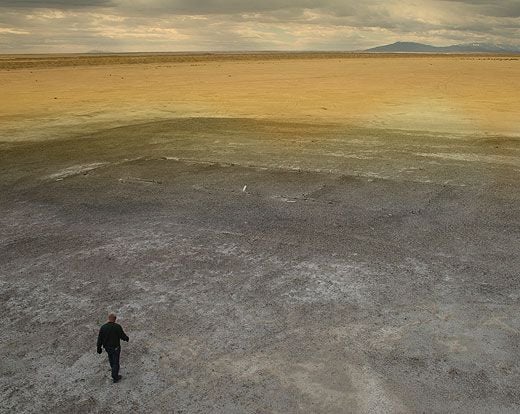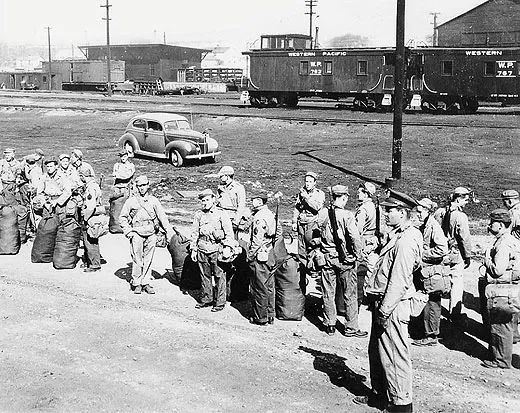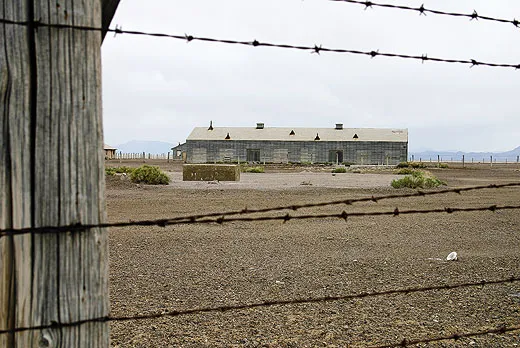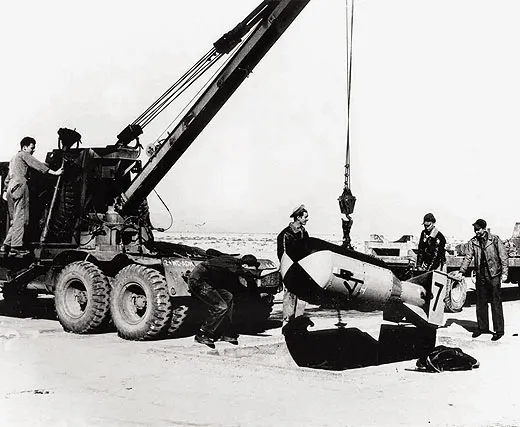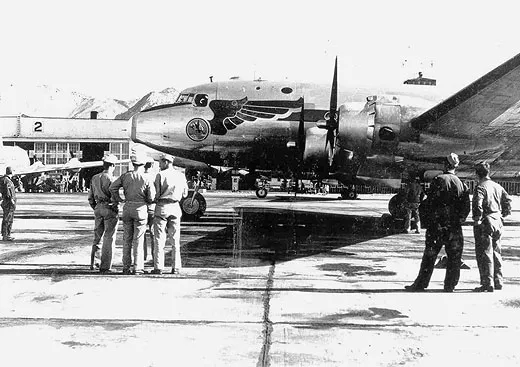How B-29 Crews Trained to Drop the Bomb
Wendover’s atomic secret
/https://tf-cmsv2-smithsonianmag-media.s3.amazonaws.com/filer/FM-2011-wendover-atomic-secret-7-GALL.jpg)
Toward the end of 1943, Manhattan Project scientists at a secret mountain laboratory complex at Los Alamos, New Mexico, began to see the final form of their new creations. The bombs that could reduce whole cities to radioactive rubble were so large and complex that they would have to be delivered by special bombers and specially trained crews. So secret was the training operation that the crewmen themselves weren’t told exactly what they were training to do. It was run out of a tiny border town in northwest Utah.
Harvard physicist Norman F. Ramsey led the bomb delivery effort. (Ramsey would later share a Nobel Prize in physics for unrelated work.) "It was apparent," he wrote later in a paper about the project, "that the only United States aircraft in which such a bomb could be conveniently internally carried was the B-29…. Except for the British Lancaster, all other aircraft would require such a bomb to be carried externally unless the aircraft were very drastically rebuilt."
The Boeing B-29 Superfortress, which was first flown in September 1942, marked a quantum leap in bomber design. Because its fuselage was pressurized, crews could operate in shirt-sleeved comfort. A flight engineer tended the airplane’s systems, freeing the pilots to concentrate on flying. The big ships handled well, although the controls sometimes required a bit of muscle. But the B-29 was imperfect. In the labored climb to the stratosphere, the 2,200-horsepower Wright R-3350-13 Duplex Cyclone engines overheated dangerously. An engine fire, fed by the magnesium used to lighten the crankcase, could sever a wing.
Still undergoing tests at Eglin Field in Florida, the bomber would become operational in the summer of 1944.
In January of that year, on orders from General Henry H. "Hap" Arnold, commander of the Army Air Forces, a B-29 from Smoky Hill Army Air Field in Kansas arrived at what is now Wright-Patterson Air Force Base in Dayton, Ohio, to be secretly modified. Six thousand man-hours later, the airplane’s two 12-foot bomb bays had become a single bay 33 feet long, allowing the longer of the Los Alamos bomb designs to be tucked into the fuselage under the wing spar. The modified aircraft was to be the first of a very limited number of B-29s rigged for nuclear combat. The program was called Silver Plated, which was eventually shortened to Silverplate. There would be 65 Silverplate bombers in all.
In March 1944, the prototype Silverplate B-29 flew to California’s Muroc Army Air Field (now Edwards Air Force Base) to begin drop tests of full-scale dummies of the first two Los Alamos nuclear devices: the 17-foot-long Thin Man and the 10-foot-long, five-foot-diameter Fat Man. During these tests, a Thin Man replica escaped from its shackles before the bomb bay doors were opened, severely damaging the aircraft. "With this accident," Ramsey wrote, "the first Muroc tests were brought to an abrupt and spectacular end."
While the B-29 was repaired and the accident investigated, a team led by Navy Captain William S. "Deak" Parsons, inventor of the proximity fuse, worked on the detonation devices and bomb design. When the plutonium acquired for Thin Man was found to contain impurities that could trigger a premature detonation, the bomb was reconfigured to use uranium-235 instead. The new design, called Little Boy, was more compact—not quite 10 feet long and about two feet in diameter—and weighed about five tons. The Los Alamos scientists thought the bombs could be ready for combat by August 1945.
The prototype airplane, meanwhile, was restored to its two-bomb-bay configuration and re-fitted with the shackle and release mechanisms the British used to hang 12,000-pounders in the Lancaster. In September 1944, the prototype flew to the Glenn L. Martin modification center in Omaha, Nebraska, to serve as a template for bringing 24 B-29s up to the Silverplate configuration, which was still evolving.
At about the same time, Lieutenant Colonel Paul Tibbets Jr., 29, was chosen to command the tactical unit created to deliver the special bombs. A B-17 commander with combat experience over North Africa and Europe, Tibbets had spent a year as a B-29 test pilot and knew the big, temperamental bomber inside and out. He believed that, once over Japan, the airplane’s performance would be more important than its protection. So he stripped his bombers of their state-of-the-art fire-control system, and of all guns and armor except those in the tail. The change pared more than 7,000 pounds from the aircraft, adding several thousand feet of operational altitude and improving maneuverability. At 34,000 feet, these stripped-down B-29s could out-turn a P-47.
Even as the Silverplates gave up their guns, the first standard B-29s touched down on Saipan, an island in the Northern Marianas that U.S. forces had taken in June 1944. Seabees (the Navy’s Construction Battalions, or CBs) were soon turning Tinian, Saipan’s southern neighbor, into a vast complex of airfields. North Field, with four 8,000-foot runways, would eventually be the world’s biggest airport, with hundreds of B-29s leaving to strike Japan.
GENERAL LESLIE GROVES, the Army engineer commanding the Manhattan Project, wanted someone on the airplane who knew about the device and could monitor its arming and fusing systems en route to a target—a crewman he called a weaponeer. His ideal candidate would be a service academy graduate and regular officer, an ordnance expert, and a combat pilot. Groves found his man in Frederick Ashworth, a young Navy commander and Annapolis graduate with a strong ordnance background who had commanded a squadron of Grumman TBF Avengers at Guadalcanal. "I met Parsons in Washington," recalled Ashworth in a 2004 lecture to Los Alamos scientists, when he was a retired vice admiral. "He told me to pick up my orders to Wendover Army Air Base in Utah."
Ashworth had first visited Wendover in 1924 while driving cross-country with his parents. Twenty years later, the bleak, bleached community, population about 100, hadn’t changed much. It lay perched on the barren eastern rim of a salt-flat desert, with its slightly larger sister city, West Wendover, on the Nevada side. The towns linked two very different cultures. Within the walls of the State-Line Hotel, for example, you could eat dinner in sedate Utah, but drink and gamble in rowdy Nevada. Civilization, in the form of Salt Lake City, was 110 miles east.
Sprawled upon the salt crust just south of town, Wendover Army Air Base had been activated in 1942, and was on its way to becoming a little Army Air Forces city of white frame barracks, family bungalows, service clubs, and a 300-bed hospital. Seven large hangars sprang up on the field, and three 8,100-foot paved runways were laid. The natural silence of the place was now shattered by the roar of B-17s and B-24s training for Europe, and later P-47s. Now it would be the B-29s’ turn, for the field had been selected as the home of Tibbets’ command, formalized in December 1944 as the 509th Composite Group.
The 509th was a veritable air force unto itself. Its combat arm was the 393rd Bombardment Squadron (Very Heavy), then training B-29 crews at Fairmont, Nebraska. Twenty Silverplate B-29s came to Wendover—15 used to train crews and five dedicated to a drop-test program for Los Alamos. The 320th Troop Carrier Squadron, known as the Green Hornet Line for the verdant livery on its C-54s, became the group’s private airline. The field was also home to the 216th Army Air Force Base Unit (Special), which included a flight-test section with an ordnance unit that made the test bombs for the drops.
Ashworth was met at Wendover by Norman Ramsey and driven into the desert, where Ramsey told him they were developing an atomic bomb. Ashworth liked the work, but said he didn’t want to bring his wife and two young children to Wendover. Ramsey managed to move him to Los Alamos. Over the next six months, Ashworth and others on his team would shuttle to the Utah field from Kirtland Army Air Base, near Albuquerque.
But the 509th and the 216th stayed at Wendover. The diverse community of airmen and -women, physicists and technicians, wives and children was an imitation of small-town America. Because everyone was young and the country was at war, most of the newcomers took the Wendover experience in stride. They accepted the rudimentary base housing, knowing they were lucky to find anything at all; many rented rooms and trailers in town. Families hiked, picnicked, and skied in the nearby pine-covered hills. Men living in the barracks played poker; some raced their cars, two abreast, down the arrow-straight two-lane highway between Wendover and Salt Lake City, sometimes passing a bottle back and forth between them. Pilots often announced their return from a training flight by buzzing their homes.
But the community was also suffocated by a pall of secrecy. Concentrating families in one remote location provided cover for the clandestine program unfolding at Wendover, and it also made dependents easier to control. The FBI and Wendover military police monitored interactions between people, and even between work areas. Airplane people were barred from talking shop with ordnance people, and never saw one of the test bomb units being assembled or loaded. Husbands could not discuss their work with wives. Telephones were tapped, letters opened. The place crawled with undercover FBI agents, trolling for leaks. People who asked or answered too many questions wound up in the Aleutians. The discernible future was a blank to everyone but Paul Tibbets and a few Los Alamos scientists.
"I’ve never been to a place that was so secret," B-29 commander James Price recalled in an interview in 2009. He had arrived at Wendover after flying B-17s on Guadalcanal and training B-17 crews in Louisiana. Like everyone at Wendover, Price had no sense of where the job would take him. Then, one evening over drinks at the officers’ club, Norman Ray, another aircraft commander, pointed out a man standing at the bar. "Ray asked if I knew who that was," said Price. "It was Dr. Ernest Lawrence," the famed physicist for whom the Livermore, California lab is named. "He was from the University of California at Berkeley. I’d read about his work before I got in the Air Force. When Ray told me that, I knew exactly what we were going to do. I wouldn’t talk in the car, afraid it was bugged. But later I told Ray, ‘We’re going to drop an atomic bomb.’"
Morris "Dick" Jeppson, who as an Army lieutenant would monitor Little Boy’s pulse en route to Japan in Tibbets’ B-29, had dropped out of the California Institute of Technology for lack of funds, and wound up at the communications school at Harvard and the radar engineering school at MIT.
Leon Smith, whose career in nuclear weaponry would span decades, was a classmate. "We were trained to go anywhere and run and troubleshoot any radar," Smith explained in a 2005 Los Alamos lecture. That included the radar altimeters aboard Little Boy and Fat Man, which, with barometric switches, would trigger the bombs about 1,500 feet above the ground.
Smith recalled that, upon arriving at Wendover, a civilian asked him to take a walk with him. "He said they wanted to build a fusing system for a new weapon. I asked if this were a biological or atomic weapon. For that I received a security investigation."
BEFORE 1944 WAS OUT, the Wendover squadrons had begun a rigorous training program. For the 509th, this meant frequent flights to practice dropping inert surrogates for Little Boy and Fat Man on targets limed on the desert floor. "We didn’t know what the bomb was," recalled Herman Stanley Zahn, one of the aircraft commanders. "All we were trying to do was drop it as accurately as we could." They also rehearsed an escape maneuver, which Tibbets had designed to get the airplane as far as possible from the expected blast. This was a kind of inside-out chandelle, beginning with a diving quarter roll from which the aircraft recovered 2,000 feet lower, and headed back the way it had come.
The 216th aircraft continued drop testing, led by Major Clyde Shields, who had piloted the Silverplate prototype. The flights were staged out of Wendover and Inyokern, California, near the Navy’s China Lake weapons proving ground. Drops were made on one range a few miles south of Wendover, and another at Sandy Beach, on California’s Salton Sea.
These missions were flown without a weaponeer, but with an electronics expert to monitor the dummy. Jeppson recalled occupying a small space behind the radio operator and next to the forward bomb bay. "We were just kind of there on a little platform," he said. "The monitoring box was hooked up to three coaxial cables into the bomb bay. We sat or kneeled."
It sounds simple enough, but Major Shields’ daily summaries compose a saga of frustration. Flights were thwarted by weather. Engines failed regularly, or went asthmatic in the thin air at bombing altitude. One engine fire largely consumed a B-29 on a Wendover runway. And then there was the incident over the little desert town of Calipatria, a few miles southeast of Salton Sea. "I was on that one," Jeppson recalled. "A Little Boy. I was monitoring my circuits, fusing, batteries, typical thing, flying at 30,000 feet." Suddenly the B-29 jerked upward. An engineer, who had gotten special clearance to be on the flight to observe how the Norden bombsight handled, had mistakenly released the bomb prematurely, wrote Gordon Thomas and Max Morgan Witts in Ruin from the Air: The Enola Gay’s Atomic Mission to Hiroshima. "It sailed over the town and landed in a farmer’s field," said Jeppson. The errant Little Boy buried itself so deep that security personnel simply filled in the hole. As for the mortified engineer, when the B-29 returned to Wendover, project agents escorted him to a car, drove him to Salt Lake City, and, after telling him he could no longer visit the base, put him on a train.
For training purposes, the inert dummies were filled with cement, carefully formulated to match the density of a high explosive called Composition B. Orange-painted bombs, called pumpkins, were stuffed with several tons of Composition B—making them the largest conventional bombs in the American arsenal.
In all, Wendover-based B-29s dropped about 155 Little Boy and Fat Man dummy bombs. The crews proved more resilient than the first generation airframes. Crews began shuttling to the Martin plant in Omaha and returning with brand-new bombers—the top of the Silverplate line. Pneumatically operated bomb bay doors flicked open and closed like aluminum eyelids. All were configured to carry Little Boy or Fat Man bombs in the forward bomb bay, with the option of carrying either conventional bombs or a 600-gallon auxiliary fuel tank in the aft bay. The Wright Cyclones had been replaced with fuel-injected engines and electrically operated reversible-pitch propellers, used to brake on landing and for maneuvering on the ground.
Jim Price and his crew flew the first new Silverplate to Wendover in April. Paul Tibbets, now a full colonel, is said to have selected his airplane as it moved down the Omaha assembly line. In Washington, D.C., Brigadier General Lauris Norstad, chief of staff of the 20th Air Force, set the stage for the 509th’s arrival in the Pacific theater. In a top-secret note to Curtis LeMay, then commanding XXI Bomber Command, Norstad explained that the 509th had been created to deliver special bombs. "[T]he first of these bombs will be available for delivery in August 1945. [They] are of two types, each weighing about 10,000 pounds. The power of each…is of the order of several thousand tons TNT equivalent.... In order to provide facsimiles of the more bulky type of special bomb, for use in training and rehearsal, the ‘Pumpkin’ has been developed….While originally designed for training…this bomb should have very definite tactical uses...in battle."
Tibbets went to Tinian in May. The full 509th complement followed on Green Hornet C-54s and by sea. In June, after a few weeks of further rehearsals with test units, 13 of the new Silverplates headed west, finally bound for combat. Curiously, no one from the 509th was around on July 16 to witness Trinity, the world’s first atomic blast, in the New Mexico desert.
Once on Tinian, the Silverplate B-29s began flying unescorted single-airplane missions to Japan, dropping the pumpkin bombs on industrial and military targets. The desired effect may have been more psychological than tactical, according to Stan Zahn. "The enemy became accustomed to single airplanes flying over," he said. And that big object falling earthward? Just another pumpkin.
Little Boy was ready to deliver by late July. The fissile material arrived from San Francisco, aboard the cruiser USS Indianapolis. After a final test of the arming and fusing system in a simulated drop near Tinian, and a few days’ wait for better weather over Japan, the bomb was loaded aboard Tibbets’ B-29, Enola Gay, on August 6 and flown to Hiroshima.
As for Fat Man, Trinity had demonstrated that it worked on a tower. But no one knew how the bomb—vastly more complex than Little Boy—would perform during a fall from 30,000 feet. Finally, in early August, the ordnance hands at Wendover assembled a test unit complete with high explosives and hoisted the device into the forward bay of another B-29. It was a Fat Man in full, lacking only the plutonium core. Dropped on August 4, it worked as intended. A similar surrogate was tested near Tinian on August 8. Next morning, the real Fat Man destroyed Nagasaki.
Frequent contributor Carl Posey last wrote about Florida’s Albert Whitted Airport.
